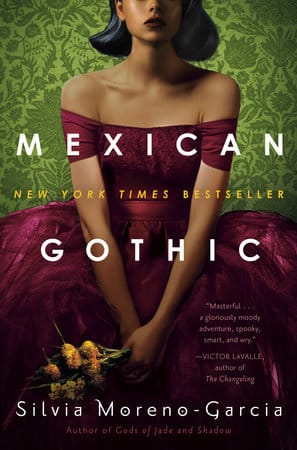Unearthing the Haunting Beauty of Mexican Gothic
Dive into Mexican Gothic, Silvia Moreno-Garcia’s novel that fuses atmospheric horror, Mexican history, and feminist bite into an unforgettable read.

Introduction
When Silvia Moreno-Garcia released Mexican Gothic in 2020, readers were immediately drawn to its glamorous 1950s setting and sinister promise: a fashionable socialite confronting the supernatural inside a decaying Mexican mansion. The novel rocketed onto bestseller lists, won the Locus Award, and earned a Hulu adaptation currently in development. Critics praised its seamless blend of atmospheric horror, feminist bite, and post-colonial commentary. Whether you are a longtime lover of gothic fiction or simply crave an intelligent scare, Mexican Gothic offers an intoxicating experience that lingers like perfume over mildew.
Plot Overview
The story centers on Noemí Taboada, a sharp-tongued debutante who would rather study anthropology than settle down. When her newlywed cousin Catalina sends a rambling letter claiming her husband is poisoning her and that the walls whisper, Noemí travels to High Place, the isolated estate of the Doyle family. There she meets the unsettlingly handsome Virgil, the shy Francis, and a household staff bound by strange rules: no talking at dinner, no hot baths, no nighttime wandering. As Catalina’s condition worsens, Noemí’s dreams fill with gold-flecked spores and the oppressive house tightens its grip, forcing her to uncover a secret rooted in fungus, eugenics, and colonial greed.
Setting and Atmosphere
High Place is more than scenery; it is the novel’s malevolent core. Perched above an exhausted silver mine in the misty Sierra Madre, the mansion is drenched in damp velvet, blackened wallpaper, and the ghostly memories of indigenous laborers who died for ore. Moreno-Garcia’s lush descriptions evoke classics like Rebecca while grounding every creak and stain in Mexican ecology. The smell of mushrooms hovers in every corridor, fusing organic rot with aristocratic decay and making readers question whether the house is dying, alive, or something disturbingly in-between.
Themes That Lurk Beneath
Mexican Gothic wields horror to examine racial hierarchy, environmental exploitation, and bodily autonomy. The Doyle family’s mania for preserving their “pure” bloodline mirrors real mestizaje anxieties and white supremacy in post-revolution Mexico. The ever-spreading fungus symbolizes how colonial ideology infiltrates, colonizes, and resurfaces long after empires fall. Noemí’s refusal to accept male authority—even that of doctors and priests—stakes a feminist claim over her body and narrative. By tying social critique to visceral dread, the book ensures that its politics are felt in accelerated heartbeats rather than delivered as lectures.
Characters as Vivid as Spores
Noemí is an electrifying departure from the passive gothic heroine. She adores couture gowns and mambo records yet capably negotiates scholarships and scientific research. Catalina, though bedridden, represents both fragile victim and fierce resistor, reminding us that agency can flicker even in captivity. Francis, the gentle Doyle cousin, complicates allyship; he is both prisoner and beneficiary of his family’s power. Even peripheral figures—the stoic housekeeper or the wary town healer—emerge in deft strokes, proving that supporting characters can throb with life, or decay, as vividly as the mansion itself.
Gothic Tradition with a Mexican Twist
Moreno-Garcia honors the gothic lineage—remote estates, family secrets, taboo desire—while upending it from a Mexican lens. The moors become cloud forests; hereditary curses become parasitic mycelium; titled nobles are replaced by mining magnates enriched through colonial plunder. By transplanting familiar tropes onto Mexican soil, the novel exposes how the genre’s European roots often ignored the colonies that financed their castles. In Mexican Gothic, the horror is indigenous to the land, blooming in the dark seams left by extractive capitalism.
Cultural & Historical Context
Set in 1950s Mexico—a period of golden-age cinema, imported American glamour, and lingering rural poverty—the novel captures a nation negotiating modernity. References to Elvis records, UNAM lectures, and Lucha Libre ground Noemí’s cosmopolitan life, while the defunct silver mine recalls Mexico’s real Bonanza era, during which foreign companies extracted fortunes and left environmental ruin. This context deepens the horror: the Doyles’ fungal dominion is simply another form of resource extraction, its victims now human bodies instead of mineral veins.
Why You Should Read It Now
Mexican Gothic is a literary shape-shifter. Horror fans will relish its body-horror crescendos; historical-fiction buffs will savor its period detail; romance readers will find slow-burn tension smoldering beneath candle smoke. The prose is decadent yet fleet, making the novel ideal for a weekend binge or lively book-club debate. With a screen adaptation imminent, now is the perfect moment to experience Moreno-Garcia’s vision unfiltered, before Hollywood inevitably trims the mold crust from its darkest corners.
Conclusion
Ultimately, Mexican Gothic endures because it entertains as fiercely as it interrogates. It delivers the pleasures of classic gothic fiction—stormy nights, locked doors, forbidden chemistry—while forcing readers to confront the aftershocks of colonialism that still ripple through modern Mexico. The next time you crave a book that will quicken your pulse and seed unsettling questions in your mind, step through the tarnished threshold of High Place. You may emerge coughing spores, but you will also carry a story that refuses to stay buried.



